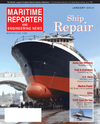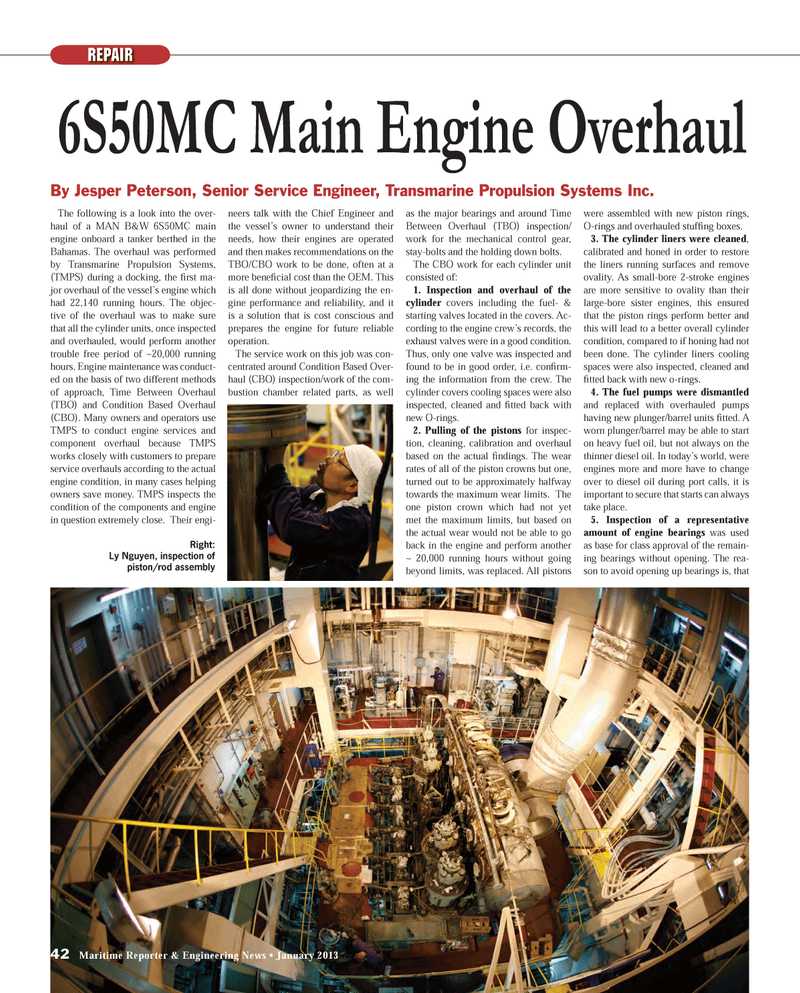
Page 42: of Maritime Reporter Magazine (January 2013)
Ship Repair & Conversion
Read this page in Pdf, Flash or Html5 edition of January 2013 Maritime Reporter Magazine
42 Maritime Reporter & Engineering News ? January 2013 REPAIR6S50MC Main Engine Overhaul The following is a look into the over- haul of a MAN B&W 6S50MC main engine onboard a tanker berthed in the Bahamas. The overhaul was performed by Transmarine Propulsion Systems, (TMPS) during a docking, the Þ rst ma- jor overhaul of the vessel?s engine which had 22,140 running hours. The objec- tive of the overhaul was to make sure that all the cylinder units, once inspected and overhauled, would perform another trouble free period of ~20,000 running hours. Engine maintenance was conduct-ed on the basis of two different methods of approach, Time Between Overhaul (TBO) and Condition Based Overhaul (CBO). Many owners and operators use TMPS to conduct engine services and component overhaul because TMPS works closely with customers to prepare service overhauls according to the actual engine condition, in many cases helping owners save money. TMPS inspects the condition of the components and engine in question extremely close. Their engi- neers talk with the Chief Engineer and the vessel?s owner to understand their needs, how their engines are operated and then makes recommendations on the TBO/CBO work to be done, often at a more beneÞ cial cost than the OEM. This is all done without jeopardizing the en-gine performance and reliability, and it is a solution that is cost conscious and prepares the engine for future reliable operation.The service work on this job was con-centrated around Condition Based Over- haul (CBO) inspection/work of the com-bustion chamber related parts, as well as the major bearings and around Time Between Overhaul (TBO) inspection/work for the mechanical control gear, stay-bolts and the holding down bolts.The CBO work for each cylinder unit consisted of:1. Inspection and overhaul of the cylinder covers including the fuel- & starting valves located in the covers. Ac- cording to the engine crew?s records, the exhaust valves were in a good condition. Thus, only one valve was inspected and found to be in good order, i.e. con Þ rm-ing the information from the crew. The cylinder covers cooling spaces were also inspected, cleaned and Þ tted back with new O-rings.2. Pulling of the pistons for inspec-tion, cleaning, calibration and overhaul based on the actual Þ ndings. The wear rates of all of the piston crowns but one, turned out to be approximately halfway towards the maximum wear limits. The one piston crown which had not yet met the maximum limits, but based on the actual wear would not be able to go back in the engine and perform another ~ 20,000 running hours without going beyond limits, was replaced. All pistons were assembled with new piston rings, O-rings and overhauled stufÞ ng boxes. 3. The cylinder liners were cleaned , calibrated and honed in order to restore the liners running surfaces and remove ovality. As small-bore 2-stroke engines are more sensitive to ovality than their large-bore sister engines, this ensured that the piston rings perform better and this will lead to a better overall cylinder condition, compared to if honing had not been done. The cylinder liners cooling spaces were also inspected, cleaned and Þ tted back with new o-rings. 4. The fuel pumps were dismantled and replaced with overhauled pumps having new plunger/barrel units Þ tted. A worn plunger/barrel may be able to start on heavy fuel oil, but not always on the thinner diesel oil. In today?s world, were engines more and more have to change over to diesel oil during port calls, it is important to secure that starts can always take place.5. Inspection of a representative amount of engine bearings was used as base for class approval of the remain-ing bearings without opening. The rea- son to avoid opening up bearings is, that By Jesper Peterson, Senior Service Engineer, Transmarine Propulsion Systems Inc. Right: Ly Nguyen, inspection of piston/rod assembly MR #1 (42-50).indd 42MR #1 (42-50).indd 421/3/2013 11:28:24 AM1/3/2013 11:28:24 AM

 41
41

 43
43
